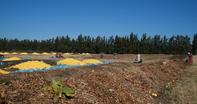Organic Fertilizers
These are made up of decomposed material originating from living organisms which creates compost and can be combined with different manures.

The decomposition process occurs through the action of microorganisms in the soil which make nutrients in this material available for absorption by plants. Organic fertilizer is applied to the soil in its natural form, in pellet form or granules.
Organic fertilizers release their nutrients slowly into the soil and should therefore be applied to the plant area well before they are required by the plant. This will prevent nutrient deficient periods for the growing plant or crop.
Compost is what is created when organic material is combined and allowed to decompose.
Manure is the dung of living creatures collected and applied to the soil to promote microorganism action.
Inorganic Fertilizers
Inorganic fertilizers or chemical fertilizers are a man-made combination of elements and fossil fuels, which are formulated and manufactured to the prescribed ratios required by various crops and conditions.
Chemical fertilizer is more immediate in its action than organic fertilizer and is available to the plant soon after it is applied. It is normally applied in granule or liquid form.
Excessive use of chemical or inorganic fertilizers alone can lead to a build-up of salts and a reduction of microbes in the soil, which causes leaching of the soil.
This is remedied by putting organic material like compost or manure back into the soil and by planting and raising green cover crops like legumes, rye and oats and ploughing them back into the soil.
Notes Using a combination of these two types of fertilizers has its benefits as this utilizes the strengths of both and overcomes each type’s limitations or negative properties. Organic fertilizer protects and keeps the natural healthy structure of the soil intact and the inorganic provides the means of faster and more precise nutrient application to the plant.